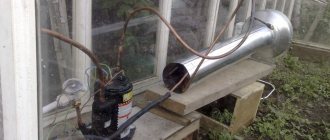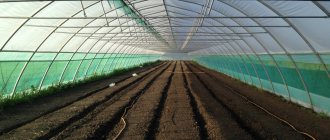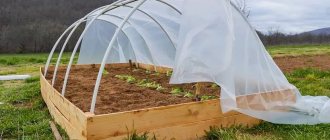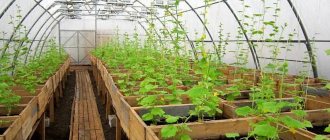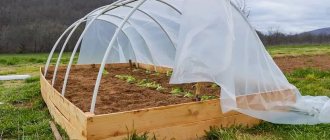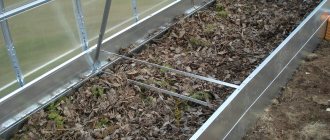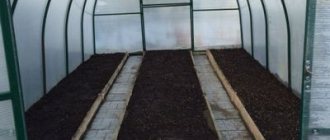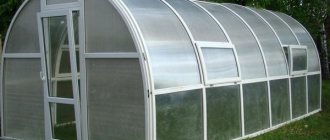Greenhouse / Heating
Our country is huge and vast. There are many climatic conditions, so the presence of greenhouses and greenhouses in our gardens is a necessity, not a whim. If you want to get a rich harvest and not waste your energy, you need to know how to keep it warm.
- 1 Solar heating
- 2 Biological heating
- 3 Reducing heat loss
- 4 Heat accumulation using bottles and water containers
- 5 Frost protection
Infrared heaters
Infrared heating is ideal for greenhouses, as it is much more economical and efficient than cable heating, which until recently was considered the most reliable. The infrared heater has created worthy competition to the cable heater, heating not the air, but directly the objects inside the greenhouse.
Thanks to this type of heating, the development and growth of plants accelerates, and the crop ripens faster and pleases with its abundance.
Here are the main advantages of infrared heating:
- the entire area of the greenhouse is heated evenly;
- humidity is at the same level, the air does not dry out;
- thanks to infrared radiation, the occurrence of pathogenic fungi and bacteria in the greenhouse is inhibited;
- heat spreads from bottom to top, slowly heating the room;
- plant growth accelerates;
- dust does not circulate throughout the greenhouse;
- mobility and compactness of heaters. They do not occupy the useful space of the greenhouse, as they are installed on the ceiling covering and are easily mounted and dismantled without outside help;
- silent operation of heaters, which has a beneficial effect on both humans and plants.
Thanks to the mobility of infrared heaters, you can easily create different temperature zones in a greenhouse and grow types of vegetables with different heat needs in this room. This is achieved by raising or lowering the heaters. To grow seedlings, heaters are lowered lower to the ground so that the soil warms up faster, and when the seedlings grow, they are raised higher.
Infrared heaters are not afraid of condensation, so they can be safely used in greenhouses with high humidity.
The principle of operation of heaters is similar to natural heating by the sun - the soil is immediately heated, and then the surrounding air, which creates an atmosphere similar to the natural one. At the same time, the plants feel great, because the air does not dry out, and the heat is soft and not scalding. The temperature relay is mounted together with an infrared emitter; the minimum temperature on it does not fall below +5 degrees, which is very good for greenhouse conditions.
Infrared heaters come in different ranges of action. Older models have a flat radiation surface, while newer ones have a spherical one, which allows heat rays to dissipate in a range of 120 degrees, which improves and balances the heating of the greenhouse, and also saves half the energy. This happens because the soil itself is heated, not the air, and heat from the soil spreads throughout the greenhouse, rising upward
It is important that each heater is controlled by a thermostat, then the difference in temperature in the center and along the edges of the greenhouse will be very insignificant
To correctly calculate the intensity of an infrared heater, you need, for example, to take a greenhouse measuring 6x3 m. For such a greenhouse, two heaters 1.7 m long and with a power of 1000-1350 W will be sufficient, which will evenly heat the entire room. The main heating zone will be approximately 2.5 m in length and 3 m in width. For longer greenhouses of 8-9 m, three heaters will be needed.
Infrared heaters weigh very little, which is also one of their advantages. They are thinner and neater than their predecessors, easy to install, emit a very soft heat, favorable for plants, which gratefully respond to growing conditions with a healthy appearance, rapid growth and rich harvests, delivering to the dinner table an abundance of vitamins necessary for our body!
Counting the number of radiators
If calculations are made for greenhouses with a ceiling height of less than 3 meters, the number of heating devices is calculated using a simplified method.
First, determine the area using the formula: S = a x b, where
S – area in sq.m.;
a and b – sides, m.
The thermal power of a greenhouse is determined by the formula: P = Sх120, where
P – thermal power, W.
Next, use the formula for determining the number of sections: n = P : p, where
n – battery sections;
p – thermal power of the section, it is indicated in the data sheet, W.
The calculated number of sections are placed evenly throughout the greenhouse, dividing them into several radiators, and you should choose devices that are minimal in height so that the soil and root zone are better heated.
Biological heating of a greenhouse using biofuel
The essence of biological heating of a greenhouse is that aerobic bacteria that decompose organic materials (manure, sawdust, garbage) when exposed to air, release heat in an amount sufficient for heating.
Biofuel is any organic material that can be consumed by microorganisms, releasing thermal energy. The temperature of biofuel can reach +72°C, therefore the process of decomposition of biofuel with the release of heat is called combustion. Hot biofuel is used in greenhouses to maintain temperatures at an optimal level for plants.
Horse manure is the best biofuel for heating a greenhouse
The following are used as biofuels:
- animal manure mixed with loosening materials (straw, sawdust, peat, leaves), see Table 2
- waste from wood processing enterprises (bark, shavings, sawdust, chips), see Table 3,
- urban waste consisting of organic waste, see Table 3.
Table 2. Characteristics of manure as a biofuel for greenhouse heating
| Characteristics of biofuel | Manure | |||
| Horse | Bovine | Pork | Sheep | |
| Weight 1m3, kg | 350-450 | 400-500 | 400-500 | 550-700 |
| Acidity, pH | 8-9 | 6-7 | 7-8 | 6-7 |
| Humidity, % | 65-70 | 75-80 | 65-67 | 73-77 |
| Max. stack temperature, °C | 60-72 | 40-52 | 55-60 | 20-30 |
| Interruption period, days | 7-9 | 18-20 | 9-10 | 20-30 |
| Avg. temperature, °C | 33-38 | 12-20 | 30-35 | 14-16 |
| Burning duration, days | 70-90 | 75-100 | 90-120 | 60-70 |
Table 3. Characteristics of household waste as biofuel for heating a greenhouse
| Characteristics of biofuel | Household waste | |||
| Sawdust | Bark | Household waste | Compost from garbage | |
| Weight 1m3, kg | 150-200 | 400-500 | 700-750 | 650-750 |
| Acidity, pH | 5-6 | 5-7 | 7-9 | 7-8 |
| Humidity, % | 30-40 | 60-75 | 35-60 | up to 50 |
| Max. stack temperature, °C | 30-40 | 40-50 | 60-65 | 50-60 |
| Interruption period, days | 20-25 | 10-15 | 10-12 | 5-7 |
| Avg. temperature, °C | 15-20 | 20-25 | 36-48 | 30-35 |
| Burning duration, days | 40-60 | 100-120 | 80-100 | 120-180 |
Read more about the characteristics of biofuels in the article: Manure and straw; wonderful greenhouse! Biofuel for heating a greenhouse
If it is necessary to protect biofuel from combustion, it is placed in a stack and compacted. In a compacted state, biofuel will not burn or will burn weakly.
To heat the biofuel, it is crushed and loosely placed in a stack; hot stones or burning coal are placed inside the stack. After 3–5 days, the biofuel begins to burn and can be used to heat the greenhouse.
Biofuel heats up well in the presence of nitrogenous nutrients. Therefore, sawdust is watered with slurry or animal urine. Mixing manure with wood waste has a good effect. Active activity of microorganisms is possible with sufficient moisture content. Therefore, biofuel is humidified if necessary.
The temperature of the biofuel reaches its maximum a week after heating and then begins to decrease. The heat generation continues for 2-3 months, gradually fading.
Heating a greenhouse with biological waste helps to utilize it, rationally using the energy stored in biofuel, and also improves the air-gas environment in the greenhouse by releasing large amounts of carbon dioxide, which plants need for photosynthesis.
Spent biofuel is suitable as an organic fertilizer both in greenhouses and open ground.
Biofuel stacking. Hot biofuel is placed loosely in the greenhouse, evenly distributed over the area and slightly compacted with a pitchfork. Fertile soil is poured onto the biofuel in a layer of 15–18 cm for growing seedlings; if seedlings are grown in pots, then the soil layer is reduced to 7–8 cm. When growing vegetable plants, the thickness of the soil layer should be increased to 20 cm.
Sowing and planting of plants begins after the soil has warmed to the optimal temperature.
The disadvantage of biological heating is that it is impossible to control the thermal regime if it is necessary to raise the temperature to the required level.
Option 3 heating with gas
The main advantage of gas is that it is more stable in terms of supply, but the final cost of products from the greenhouse can surprise. Therefore, if heating a greenhouse with gas in winter lasts only a few weeks, then it is not necessary to pull it from a residential building and purchase expensive pipes for this. It will be enough to take a couple of cylinders for this purpose - they will last for a long time.
It is only important to remember that excess carbon dioxide can negatively affect the condition of plants, and therefore such a greenhouse must be well ventilated. And to remove combustion waste, it is necessary to use an exhaust device so that a constant flow of oxygen into the greenhouse is ensured
And so that the lack of oxygen does not lead to the cessation of the combustion process and the release of gas into the air, it is advisable to use heating devices with an automatic protective device - the sensors will immediately operate as soon as the gas supply to the burner stops.
Heating a greenhouse with water heating
When growing a large volume of commercial products, when there is economic benefit, it is advisable to use water heating in the greenhouse.
Water heating in the greenhouse allows the structure to be used all year round, supplemented with sodium lamps to compensate for the short duration of daylight hours.
The hot water boiler is selected based on the area of the greenhouse and the volume of air in the room, and then installed in the vestibule so that flue gases do not enter the greenhouse. Heating pipes are located longitudinally, along walls, under shelving, under the roof, etc.
The hot water boiler for the greenhouse is selected according to the size of the structure
Heating pipes can pass under a layer of nutrient soil, for example, in pit-type greenhouses. A layer of sand 10 cm thick is poured onto the bottom of the pit, and pipes for hot water are laid on it. They are covered with 10–15 cm of sand on top, and a 25 cm layer of nutritious soil is poured onto the sand.
Soils for greenhouses and greenhouses
In greenhouses and greenhouses, root nutrition conditions differ from the nutrition conditions in open ground. Frequent and abundant watering contributes to the leaching of nutrients, and repeated fertilizing contributes to the accumulation of ballast formations in the soil. These features require the creation of special soils that can provide favorable conditions for plants.
Soils for a greenhouse must have:
- fertility,
- good air and water permeability,
- be loose
- have good moisture capacity and retain nutrients well.
For greenhouses, the best soils are those that have a neutral environment, in which the ratio between solid, liquid and gaseous phases is 1:1:1. This means that they contain a large amount of loosening materials.
The main components for creating soils are lowland peat, turf and field soils, manure humus, old (spent) greenhouse soil, sand:
- lowland peat of weak or medium degree of decomposition - 75% + turfy medium loamy soil - 25%;
- lowland peat 60% + turf soil 20% + manure 20%;
- field medium or light loamy soil 50% + manure humus 30% + lowland peat 20%;
- turfy medium loamy soil 50% + old greenhouse soil (2 years after use) soil 50%;
- chernozem soil 80% + humus 20%; lowland peat 70% + manure humus 20% + sand 10%.
Materials intended for greenhouse soils are passed through a screen and mixed well.
A good component for soil soils are composts and leaf soil, for the preparation of which leaves that have fallen from trees are placed in a wooden box in the fall and watered with water, slurry or urine. Within 2–3 months, the leaves decompose and turn into an earthy mass; it is passed through a screen and added to the soil (up to 30% of the total volume).
Composts from waste from wood processing plants (shavings, sawdust, bark, small chips) can be added to soils as a loosening material. When composting, 44 grams of urea and 15 grams of superphosphate are added to a bucket of fresh waste, mixed thoroughly, moistened and placed in a stack or heap for 2-3 months. Ready compost can be added to peat soil (up to 30%).
The layer of soil for growing plants in a greenhouse should be 25 cm, or 0.25 m3 per 1 m2 of useful area of the greenhouse.
In film greenhouses, where plants are grown on natural soil, manure (15–20 kg/m2) or lowland peat (20–25 kg/m2) is added if the soil is light; for soils of heavy mechanical composition, add another 10–15 kg of composted wood-based materials or sand - a bucket per 1 m2.
Mineral fertilizers are also added to the greenhouse soil:
- ammonium nitrate 60–90 g/m2;
- superphosphate - 30–40 g/m2;
- potassium chloride - 10–15 g/m2.
In the fall, after applying fertilizers and loosening materials, the soil is dug up to a depth of 25 cm so that the organic fertilizers and loosening material begin to decompose, and the pests that have prepared for the winter die.
Recommendations
When choosing an IR heater, it is important to pay attention to its power. Devices should be selected taking into account the size of the room. Usually, to heat 10 m2, a device with a power of 1000 W is required, but it is better to purchase units with a reserve
If a wall-mounted heater is selected, it is important to find out the thickness of the foil layer of the emitter. Its indicators must be at least 120 microns. Otherwise, a significant part of the energy will be spent on heating the ceiling
Usually, to heat 10 m2, a device with a power of 1000 W is required, but it is better to purchase units with a reserve
If a wall-mounted heater is selected, it is important to find out the thickness of the foil layer of the emitter. Its indicators must be at least 120 microns
Otherwise, a significant part of the energy will be spent on heating the ceiling.
Manufacturers produce heater models with various functions. You need to think in advance whether they will be used during operation, otherwise there is a high risk of overpaying for something that will not be useful in the future.
Devices may have the following options:
- regulation of temperature parameters;
- automatic shutdown of the device when it is turned over (mobile variations);
- shutdown of equipment in case of possible overheating;
- turning the unit on or off at the right time.
Before purchasing a device, you should carefully inspect its case. It can be made of steel or aluminum. The first options are more durable, the second – stylish design. There should be no traces of mechanical stress or rust on any of the housings. Corrosion can reduce the service life of the device declared by the manufacturer.
Possibilities of a heated greenhouse
A heated greenhouse has greater capabilities than a conventional structure not equipped with such a system. Using a heated room for growing herbs, berries, fruits or vegetables, the grower will be able to obtain harvests throughout the year (subject to the installation of a lighting system). In a heated greenhouse, optimal temperature and humidity levels are maintained, despite frost. Thanks to the creation of an artificial microclimate, it is possible to increase the percentage of seed germination, protect seedlings from various fungal diseases, and also harvest crops earlier than others.
By heating the greenhouse, you can obtain berries and vegetables throughout the year, collecting them several times. Thanks to a greenhouse, it is possible to create a winter garden or flower greenhouse in the cold season, increase the flowering time of crops, or grow exotic plants that are not adapted to the local climate. The above factors can significantly increase the profitability of the site and increase revenue if the greenhouse is used to grow plants for sale.
Convectors will also work
You can heat the greenhouse with electric convectors. They are installed on the walls of the structure and on the floor. Convectors heat the air well, they have timers that can be set to a certain temperature, and they will turn on and off themselves. One drawback is that they are quite energy-consuming, and electricity is now expensive.
How can I heat
In early spring, greenhouses can be heated in several ways, the choice of which will primarily depend on the purpose of the room. If you plan to heat a small building in which you grow vegetables for yourself, there is no point in purchasing expensive industrial installations. In this case, various stoves or boilers are suitable.
Stove heating in greenhouses was used 20-25 years ago, but it is still relevant today. For these purposes, gardeners and gardeners use specialized boilers or barbecues designed to maintain optimal temperatures. When using stoves, heat is generated by burning fuel. The advantages of such a system are its simplicity and low cost of maintaining the temperature, while its disadvantages are low productivity and labor-intensive operation.
Heating of large polycarbonate greenhouses can be done using water or electric heating. In the first systems, it is necessary to use boilers, pumps and pipelines through which the hot coolant will move. With water heating, heat is generated by burning gas or using electric current.
Electric heating involves the use of electrical appliances to heat the air in the greenhouse.
Heating using cables. The principle of operation of such a system is simple: the heat cable is installed under the ground (similar to the installation of a heated floor) and connected to power sources. When turned on, it will heat the soil, and from it the heat will spread throughout the room. The system is economical and efficient. Most often it is used in greenhouses for growing plants in early spring or late autumn. This heating method is ineffective for heating a room in the winter.
Year-round greenhouses can be heated using gas systems. For these purposes, summer residents and gardeners often use catalyst burners connected either to the main gas pipeline or to household cylinders. Gas heating is suitable for warming up both large and small-sized greenhouses in the winter. The best heating systems are those that use infrared (IR) heaters. They have many advantages compared to other heating options.
The principle of operation of IR devices is similar to the effect of sunlight on plants. The equipment emits heat, which is absorbed by surrounding objects and subsequently transferred to the air. Depending on the type of installation, the room can be heated from above or below. Some growers organize high-quality heating from all sides. However, this heating method is one of the most expensive.
Often, heaters are placed on the ceiling surface above the beds. The weight of one device is relatively small - its weight does not exceed 5 kg. Most modern greenhouses allow you to place any number of such units. Installation of IR equipment is not complicated, so installation can be done with your own hands without the involvement of hired craftsmen.
DIY installation
Owners of dachas, private farms, vegetable gardens, and small farmlands use interesting heating systems.
We will talk about an unusual way of growing early vegetables using alternative methods of heating the soil, that is, with the help of the sun:
- In early spring, cover the prepared beds with film;
- the sun through the shelter will heat the soil to the desired temperature;
- then, without removing the covering material, holes are pierced, the seed is placed in the soil and covered with earth on top;
- in a warm environment the seeds will germinate early. As soon as the first shoots appear, the arcs that were previously laid out on the bed rise;
- the plants continue to grow in the sun-heated greenhouse;
- when a period of spring weather without frost arrives, the material is removed and stored until next spring.
With this method, a good early harvest is obtained.
Turnkey heating system installation
Some construction campaigns offer farmers to build turnkey small industrial greenhouses according to standard designs, priced with heating at the customer’s choice.
Advantages and disadvantages of the service
Among farms, such services are in great demand due to the undeniable advantages over homemade products:
- reliability;
- full or partial automation of the process;
- the ability to program the necessary agrotechnical parameters for different vegetables;
- modern low-cost heating systems that allow you to grow many useful plants all year round;
The only drawback is the cost: from 100,000 rubles. up to 500,000 rubles.
Price
Consists of the following components:
- design;
- frame manufacturing;
- system configuration;
- delivery to the installation site;
- installation of structure and heating;
- commissioning operations;
- commissioning.
Cable heater
This heater consists of a cable in special polypropylene insulation, braided armor made of galvanized steel wire and a special sheath. Cable diameter is 6 mm, bending radius is 35 mm.
The main advantages of a cable heater are:
- relatively easy installation;
- acceleration of plant growth;
- extension of the growing season of vegetable crops;
- increasing the number of plant species grown;
- a bountiful harvest;
- possibility of regulating soil heating.
Typically, with cable heating, the electricity consumption is 75-100 W/sq.m. Special thermostats are designed to regulate the temperature.
The optimal temperature for soil is 15-25 degrees, and for seedlings in peat pots - 30 degrees. When heating the soil with an electric cable, the heating element itself is also located in the soil or under the ground in an asphalt concrete monolith. When heating air, heating elements are suspended in a special way, and then voltage is applied to them. Heating elements can be hidden in pipes, which perfectly protect them from various damage and moisture. True, you will need a lot of such pipes.
The safest cable batteries are made in the form of an asphalt concrete sheet or asphalt expanded clay concrete slab. They have excellent accumulation properties and warm the soil much more evenly. And most importantly, they are absolutely electrically safe.
Advantages and disadvantages
Every year, an increasing number of plant growers refuse to use outdated systems for heating cold greenhouses. Today, it is rare for anyone to heat their premises using “stove stoves”, fan heaters or boilers using coal or wood fuel. All these methods are becoming a thing of the past, since they have a significant drawback. These systems heat the air, which, according to the laws of physics, tends to rise, leaving the crops being grown cool.
Infrared heaters have been able to solve this and many problems of heating a room once and for all.
Compared to other systems, they have a number of advantages.
- Optimally distributes heat around the entire perimeter. Most types of thermal devices presented on the modern market cannot boast of this effect.
- Quick heating of the room. The spread of heat is felt already in the first minute after turning on the device. The devices operate in a directional manner, making it possible to evenly heat a specific area. Due to this feature, heat-loving plants and crops for which thermal energy is not so important can be grown in one greenhouse.
- Economical consumption of electrical energy. With proper installation of equipment, it is possible to achieve energy savings of up to 40%.
- Elimination of drafts and movement of warm air currents, which not all plants like.
- Silent operation of devices.
- Elimination of “burning” of oxygen in the air. Thanks to this feature, optimal humidity is maintained indoors. This is one of the most important conditions for good growth and fruiting of plants.
- Durability of devices and their uninterrupted operation. The fact is that IR equipment does not include moving mechanisms and rubbing parts that need frequent replacement.
- Small dimensions and weight of the units, making them easy to transport and install.
Unfortunately, no heating equipment is without drawbacks. Infrared heaters also have disadvantages. These include the high cost of organizing an infrared heating system and the low fire safety of some models (mainly mobile units). In addition, there are counterfeits of equipment from well-known brands on the market, which is why the buyer runs the risk of purchasing a low-quality product.
Common Mistakes
One of the main mistakes that often occurs is a lack of planning. Before starting work and in the early stages, you can still make corrections so that you don’t have to redo the work later. It is necessary to think in advance about the purpose of the greenhouse, make an estimate and calculate the costs and time.
If work is done in a hurry, the risk of errors in details increases. Ultimately, you can end up with significant heat loss from the structure, incorrectly functioning equipment, and difficulties in servicing components and assemblies.
Problems also occur due to errors in calculations. For example, when the area of the room and the power of the boiler were incorrectly correlated. If the power is low, then heating will not be enough. And if it is more than needed, this will lead to additional costs.
Gas, oil and primitive types of heaters
To choose the right heater for a greenhouse, you need to immediately determine what exactly will be grown in it, what size the greenhouse is, its thermal conductivity, and in what season the heating will take place.
If the seedlings in the greenhouse are freezing, it may be enough to install a few lit candles. Another thing is a greenhouse 2.5 meters high and an area of 20 sq.m. For such a greenhouse, completely different dimensions of the heater are required. Without heating, the greenhouse can withstand temperatures down to -1 degree, and below that, additional heating is already necessary. For this purpose, you can use fan heaters equipped with a timer, in which you can specifically regulate the duration and power of operation, as well as automatic shutdown.
The advantage of fan heaters is its ability to quickly heat the air, but the disadvantage is the unevenness of the heat supplied and drying of the heated air.
The worst of all greenhouse heaters is the gas heater. It consists of a gas pipeline and a gas control system. The heat generator heats the air and transfers it to the greenhouse. The disadvantage of this heater is also that the air in the greenhouse dries out, which is detrimental to the plants.
Sometimes oil heaters are used in greenhouses, which is very irrational. They consume too much electricity, which, if used for a long time, will not be repaid by any yields. In addition, such heaters take up too much space and are not protected from condensation.
This applies to all electric heaters connected to the network. The slightest short circuit and a fire cannot be avoided. If dew falls in the greenhouse, it will settle on all surfaces, including the outlet. If a drop hits the current line, a short circuit may occur. It's good if the fuse blows. In the worst case, the socket can catch fire when the owners are not at home
Therefore, all precautions must be taken to prevent this from happening. The outlet should be outside the greenhouse, preferably inside the house, it should be sealed so that water cannot get into it
The heater should not be left on if no one will be at the dacha for a long time. For the heater, it would be a good idea to install a circuit breaker with a small power reserve, so that in the event of a short circuit it will turn off the voltage. A 500-watt heater requires a 3-amp circuit breaker that can operate with a current leak of 0.03 amperes.
Battery heater
The best option for heating a greenhouse is an autonomous heater, which has its own energy source that does not depend on external factors, such as power outages or power outages. You can build it yourself by converting it from a car battery and adding smoldering peat to it.
The car battery has 55Ah, and the entire greenhouse requires at least 500 watts. Therefore, experienced gardeners came up with the idea of using a battery in pulse mode, which operates as follows: using a clock mechanism, the burning is turned on, the spiral burns out and the contact breaks, after which the tinder in the peat is ignited. After some time, the next spiral is connected. This mode saves battery power, which will last for a whole week or even more.
Samopal
The simplest and most primitive way to heat a greenhouse is “homemade”. It works as follows: garbage is burned in the stove, in which two bricks and a bucket of water are heated. In the evening, in the greenhouse, a bucket of water is placed on a wooden stand, and hot bricks are placed on a sheet of iron.
Some gardeners use candles, which are placed in the middle of the greenhouse along the path and set on fire. This is an ineffective heating method, but it looks very nice.
Pechnoe
In addition to solid fuel boilers, there is another way to use solid fuel in greenhouses - these are various stoves made of metal or brick.
Advantages and disadvantages
Brick is more difficult to heat, but it also loses heat more slowly than steel. This will make it much easier to maintain a stable temperature in the greenhouse. A brick oven does not dry out the air, and its humidity is extremely important for plants. You can compensate for the shortcomings of an iron stove by installing an additional circuit of registers or radiators inside.
Metal heating devices also have a strong side - they are preferable for greenhouses operating in spring and summer:
such structures can be installed for a short time;
- there is no need for a complex foundation;
- the oven takes up relatively little space;
- the cost of the product is less than that of the brick version;
- all work can be completed without turning to professionals.
Selection and installation of the furnace
The chimney system of a metal stove must be installed at an angle of at least 15 degrees. This step increases the heating power. The pipe must be made of metal; it does not need to be insulated, except at the intersection with the roof or wall, since protective boxes are installed there. Before installing stoves, you need to consider their stability - if the stove tips over, the greenhouse may be damaged, and in the worst case, a fire will start.
There are many different designs, but the Vesuvius-mini potbelly stove is deservedly considered one of the best. This is a compact and cheap stove, the design of which is simplified as much as possible. Using a device with a thermal power of 4 kW, you can warm a greenhouse with a total area of up to 25-30 square meters. m. Wood is burned inside the steel body, and water can be heated from above. It is also possible to use Vesuvius-mini as a stove.
“Cinderella” is also a compact device, made of an alloy that is resistant to strong heating. With the help of side convectors, the distribution of hot air is improved, the total thermal power is 6 kW, the heated area can be up to 60 sq. m. m. Control of the stove operation is facilitated by a viewing window in the door; a burner for heating water is installed on top. Firewood or household waste is placed in the oven.
The advantages of the “Normal” system are increased energy production (it warms up greenhouses with dimensions of 60-80 sq. m), as well as special protective covers that prevent the side walls from warming up to dangerous values. The designers took care to securely lock the door to prevent smoke.
In turn, if you choose the Klondike NV-100 stove, you can ensure a long-term supply of heat to the outside - up to 10 hours in a row. And those who want to heat a greenhouse with wood processing waste or cardboard should take a closer look at the Breneran Aquaten design. This is a gas generator furnace with a water circuit.
For your information: of course, no stoves work with waste oil. But heat guns can quite use it.
Whatever the owners choose, it is necessary to prepare a strong foundation, for which they lay sidewalk tiles, bricks, or simply compact the earth. The best place to install stoves is in the middle of the greenhouse, as this makes heating more uniform. If there is a main wall, the back wall of the stove should be leaning against it.
Types of infrared heaters
Infrared heaters of the following types:
- light;
- long wave.
In IR light heaters, the surface heats up to 600 degrees. This equipment is suitable for very large greenhouses. Long-wave devices heat up much less and are better suited for small greenhouses.
Infrared devices can operate from:
- electricity;
- gas;
- liquid fuel.
Infrared heaters for greenhouses are able to heat a greenhouse with an area of 18 square meters. m. When operating on gas, only two cylinders of liquefied gas are consumed during the winter.
The shape of such heating devices is different. They are produced in the form:
- lamps;
- film (tape) panels.
Briefly about the main thing
There are many options for heating a polycarbonate greenhouse during frosty weather. The main types are natural and artificial. Natural heating with manure has been known for many years, but it alone is not enough. The second type is divided into several types. Soil insulation is done using expanded clay. The stove heats well, but is not autonomous - you need to heat it every 3-4 hours, that is, constantly stay in the same area.
Electricity can be used for heating. This way you can create a “warm floor”, that is, burn the soil, equip the walls with heat fans and infrared heaters. Gas is also a common form of heating. This category includes gas cylinders, convectors and heaters with infrared sensors.
Greenhouse boron heating
Bore heating of the greenhouse is carried out by hot flue gases coming from the brick oven through the hog on the way to the chimney. Essentially, the hog is the beginning of the chimney, located almost horizontally along the greenhouse.
When hot gases pass through the chimney, heat is accumulated by the walls of the hog and then, when cooled slowly, heats the greenhouse.
The stove is installed in the end part of the greenhouse so that the combustion door opens into the vestibule, and the stove itself is located in the greenhouse. A hog runs along the greenhouse from the stove, placed on brick trenches so that there are air passages in the lower part of it and there is no contact between the hog and the ground. From the stove to the chimney, make a slight rise in the hog (at least 1:100) to prevent smoking.
In lean-to greenhouses, hogs are placed along the south wall under the shelving. In gable greenhouses, two hogs (respectively, two ovens) are laid under the racks running along the side walls. The riser must be of sufficient height to provide good traction.
Heating a greenhouse with a heating cable is an original and economical solution. It is used in Alaska.
The stoves are heated in the evening, and in severe cold weather - in the morning, in order to maintain the thermal regime at a sufficient level.
Variety of metal stove models
The range of stoves for greenhouses is large, but first of all, their thermal power and functionality are taken into account.
The following products are most popular among consumers:
- "Vesuvius mini" This inexpensive and compact potbelly stove has a simple design; it runs on wood. Its productivity allows you to heat a greenhouse whose volume does not exceed 80 cubic meters. The body of the product is made of steel. Its surface can be used as a stove for heating water, humidifying or watering.
- "Cinderella". The small unit is made of heat-resistant steel. It is equipped with side convectors that distribute warm air. A power of 6 kW will be enough to heat a greenhouse with an area of 60 square meters. There is a glass window in the door of the combustion chamber, thanks to which you can observe the process of burning wood. On the upper surface there is a burner for heating water. Wood or garbage is used as fuel.
- "Teplodar Pechurka Plus" It has a power of 5 kW, sufficient to heat 50 “squares” of area. The product is small in size and weight, it is equipped with a casing with convection holes that promote uniform release of thermal energy. There is a burner on the surface, the fuel used is firewood.
- "Normal". The stove's power of 6 kW is enough to heat 60-80 square meters of the greenhouse. The sides of the unit are protected by casings that have convection holes, and therefore they do not warm up to temperatures dangerous for plants. A tightly closing door prevents smoke from entering the room. Thanks to the convenient ash box, it can be collected and used as fertilizer.
- "Klondike NV-100" is a bulerian with a capacity of 6 kW. The unit is capable of heating a room with an area of 60 square meters. The combustion chamber consists of two chambers and operates as a gas generator. The walls of the firebox consist of hollow pipes. In the first chamber, firewood is burned, and in the second, combustion gases are burned. Cold air moves from below, heats up and is discharged through the top of the buleryan. Due to constant air exchange, it does not overheat. It is possible to connect air ducts to pipes. The stove has a long burning mode for 10 hours.
- "Breneran AQUATEN." The stove is equipped with a water circuit and, with a productivity of 6 kW, can heat up to 60 square meters. m. The water jacket of the unit is located along the walls of the firebox. The device operates like a gas generator, and has compact parameters and high efficiency. Works on firewood, wood waste, branches, etc.


